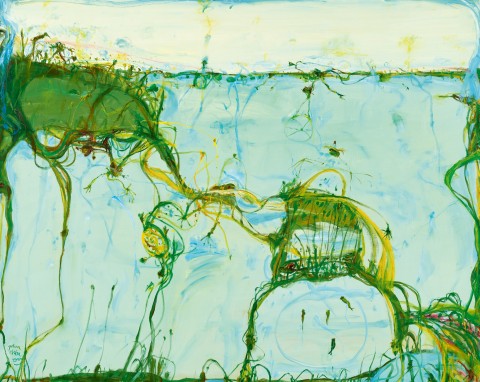WETLANDS, 2000
JOHN OLSEN
oil on canvas
200.0 x 250.0 cm
signed and dated lower left: John / Olsen / 2000
Tim Olsen Gallery, Sydney
Private collection, Sydney, acquired from the above in 2000
McGregor, K., and Zimmer, J., John Olsen: Journeys Into the You Beaut Country, Thames and Hudson, Melbourne, 2016, pp. 214 (illus.), 339
Wetlands, 2000 was reproduced as a fine art limited edition print by Digital Art Directory, Bowral, New South Wales
There are many ways of looking at the dilemmas of the latter part of the 20th century with it’s atom bomb. It presents a huge question mark and the imminent or possible destruction of the world itself. Yet one thing that really strikes you in the environments I was working in is the abundance and generosity of life and life forces. The urge for life is a staggering thing and we just ought to take notice… There is such fecundity in this universe called a lily pond.1
Now 93 years of age, John Olsen’s career has spanned an extraordinarily long period, during which he has created an oeuvre of considerable breadth and continuing vitality. Large and immersive, Wetlands, 2000 rejoices in the fecundity and interconnectedness of the natural world. With fluid and sensuous meandering lines and layered washes of blue, green and yellow Wetlands shimmers with tropical liveliness and delicate harmony. In the 1970s, disillusioned with Sydney’s relentless pace and cutthroat ambitions, Olsen went to find solace in rural Victoria, where his friend Clifton Pugh lived. Since then, he has immersed himself in the physical landscape and reconnected with painting en plein air, grounded in a practice of intimate observation of the natural world. Olsen once described himself as a ‘wandering minstrel’ 1 travelling through the country and painting its unique strangeness into his artworks. Barry Pearce went one step further, describing the artist as a ‘poet of the brush…brave enough to go into the desert, the bush, wetlands and embrace it with love; absorb himself in the landscape like a true poet.’2
In a logical continuation of the meandering and freeform nature of his You Beaut Country paintings, Olsen’s landscape and marine paintings are teeming with animal and vegetable life, organisms competing for resources and attention. These paintings explored processes of natural organic growth and delicate symbioses. Nourished by the conviction that movement was essential to both life and art, and that everything was in constant state of flux, Olsen painted these works with inexhaustible enthusiasm. From the minutiae of a pond or rockpool to panoramic aerial views of lakes and meandering rivers, Olsen found artistic parallels between the structures of these biomes and the relationships that connect them: ‘When one begins to see nature as a series of processes, the appearance of the object change – form follows function … I would like to make the viewer see the microcosm and the next moment the expansiveness of the universe’. 3
The marine world has provided Olsen with a seemingly endless source of fascination and wonder throughout his life, following the continual flux of the tides and examining the microcosms and sensuous lines of sea and the harbour. Expansive in scale, Wetlands is immersive and dense with humorous painterly passages. The entirety of this watery microcosm is contained, stretching out towards the high and pale horizon and pushing against the edges and corners of the frame. Olsen’s iconic frogs peer out from Wetlands’ watery depths, leaping out from layers of algae while a lazy turtle floats in an eddy in the middle of the pool and a fat little jacana bird with spindly legs hovers above a lilypad. Olsen infuses his mystic paintings of the natural world with a generous pinch of humour and a great deal of artistic liberty, what Bernard Smith qualified as ‘vitalism and colouristic exuberance’.4
1. The artist, quoted in Hart, D., John Olsen, Craftsman House, Sydney, 1991, p. 125
2. Barry Pearce cited in Hawley, J., The Masterly Mr Squiggle, Good Weekend, September 2, 2006
3. The artist, John Olsen, My Complete Graphics 1957 – 1979, Gryphon Books, Sydney, 1980, p. 132
4. Smith, B., cited in Hart, D., ibid, p. 79
LUCIE REEVES-SMITH
